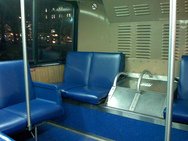Big plans for better transit in Ward 5 will take some time

Photo by Fredo Alvarez on Flickr.
WMATA and DDOT officials’ upbeat presentations of progress being made to improve transit alternatives in DC contrasted with the complaints of Ward 5 residents about the spotty bus service in their neighborhoods at a Thursday evening forum.
Only 8 residents attended the event, the last of a four-part listening tour conducted by Public Works and Transportation committee chairman Tommy Wells. Participants were asked what does and does not work for them for getting around the city.
“There’s no reason DC can’t have a robust bus system” that is integrated with information systems like NextBus, said Wells. Such a system that works for everyone can make transit affordable and feasible for seniors, families, and individuals of all income levels to live in DC.
“The number one thing that we want economic development to be is transit-oriented,” added Ward 5 Councilmember Harry Thomas Jr. Thomas discussed the need to make development projects along the New York Avenue NE corridor accessible by modes beyond just driving. Some of his suggestions included improving bus service and expanding Capital Bikeshare.
Thomas touted a soon-to-be-unveiled program where people can apply to be awarded a $50 SmarTrip as encouragement to use public transit more often. He also announced that a formal application had been made to change the name of the New York Avenue/Florida Avenue/Gallaudet University Metro station to NoMa.
WMATA Senior Bus Planner Jim Hamre reviewed bus operation changes that took effect in December, many of which have been discussed at length here, and discussed present and future planning processes.
The average age of the Metrobus fleet is as low as it has ever been, Hamre touted, with the agency having introduced “some of the best buses in America” over the past two years. He also discussed investments that have been made in WMATA’s largest bus garage, the Bladensburg Road facility. That facility now houses 226 buses, including the entire compressed natural gas-powered fleet.
Hamre announced the following work that WMATA is undertaking:
- A route 99 express bus will be implemented in 2012, making limited stops along the 90 route between Anacostia Metro and Dupont Circle (diverting from the 90 route at 18th and U Streets NW via Florida Avenue).
- A just-completed study of route B2 (Anacostia to Mount Rainier via Bladensburg Road) recommended that the route be split in half at Stadium-Armory to improve timekeeping. (Interestingly, an X6 bus once ran between Minnesota Avenue Metro and the National Arboretum in an effort to provide better access to the Arboretum, but suffered poor ridership and a funding cut.)
- The E-series crosstown buses are now being analyzed, with public workshops soon to be announced.
- Major service enhancement is planned for the P-series (Anacostia to Rhode Island Avenue Metro via downtown), possibly including the elimination of route P1 or a reroute of P2 to cover more of the P6 route.
- Future studies will focus on route 80, 82 and G8. The 80 route study will consider a new route that would follow North Capitol Street and Blair Road all the way from Union Station to Takoma.
- Beginning in June, WMATA will undertake a two-year program to replace all the bus stop flags in the system with ones that have reflective coating, larger type, and show the stop ID number and the NextBus phone number and website on the flag.
Other areas WMATA is investigating include improving bus connections to three of the four future DC Walmart locations, expanding bus capacity at Fort Totten Metro, and improving the movement of buses along New York Avenue (the way most buses get from the Bladensburg garage to their assigned routes). For all future bus improvements, Hamre reminded the audience, local funding is key.
DDOT Progressive Transportation Services Director Scott Kubly reviewed his division’s progress towards meeting the goal of doubling Capital Bikeshare’s reach within two years. He announced that CaBi just broke 9,000 members, and is now the most well-used bikeshare system in the world on a per-bicycle basis: 3,000 daily trips are made on CaBi, more than half the number who ride Arlington County’s ART bus system every day.
Finally, Kubly touched on efforts to improve pedestrian and bicycle access to the Rhode Island Avenue Metro station, including the construction of a bike/pedestrian bridge over the CSX railroad tracks to connect to the Metropolitan Branch Trail.
During the question-and-answer session, attendees unleashed complaints about their difficulties getting around on transit. An Edgewood resident says she now drives to the Rhode Island Avenue Metro station to get to work downtown rather than wait for the unreliable and slow G8 or D8 buses. A Trinidad resident asked what could be done to calm speeding traffic on Florida Avenue NE. There were numerous complaints of bus bunching and NextBus’s unreliability.
